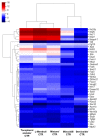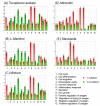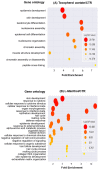A Mixture of Tocopherol Acetate and L-Menthol Synergistically Promotes Hair Growth in C57BL/6 Mice
- PMID: 33353178
- PMCID: PMC7766712
- DOI: 10.3390/pharmaceutics12121234
A Mixture of Tocopherol Acetate and L-Menthol Synergistically Promotes Hair Growth in C57BL/6 Mice
Abstract
Oral finasteride and topical minoxidil are single components approved by the US FDA for treating hair loss. Some other compounds originating from natural products are also traditionally used for promoting hair growth. In this study, observations of treated keratinocyte cells were used to demonstrate that tocopherol acetate, L-menthol, and stevioside exert an effect on cell regeneration. Furthermore, these were topically applied to the shaved skin of C57BL/6 mice to observe their effects on hair growth. A mixture of tocopherol acetate, L-menthol, and stevioside showed the highest potential for promoting hair growth in vivo. In in vivo experiments, the mixture of tocopherol acetate, L-menthol, and stevioside was more effective than tocopherol acetate or L-menthol alone in promoting hair growth. The transcriptome analysis of skin from the dorsal side of a mouse treated with tocopherol acetate or L-menthol versus vehicle revealed key changes in keratin, keratin-associated protein, forkhead box, sonic hedgehog, fibroblast growth factor 10, desmoglein 4, deoxyribonuclease 1-like 2, and cadherin 3, known to play roles in promoting hair growth.
Keywords: functional gene clustering; hair cycle-related gene; skin development; synergistic effect; transcriptome analysis.
Conflict of interest statement
The authors declare no conflict of interest.
Figures






Similar articles
-
Comparison of Saccharina japonica-Undaria pinnatifida Mixture and Minoxidil on Hair Growth Promoting Effect in Mice.Arch Plast Surg. 2016 Nov;43(6):498-505. doi: 10.5999/aps.2016.43.6.498. Epub 2016 Nov 18. Arch Plast Surg. 2016. PMID: 27896178 Free PMC article.
-
[Effects of Skin Environmental Changes by Steam Towel, Ethanol, l-Menthol and Carpronium on the Drug Behavior in the Minoxidil Nanoparticles-applied Mice].Yakugaku Zasshi. 2022;142(9):1015-1020. doi: 10.1248/yakushi.22-00103. Yakugaku Zasshi. 2022. PMID: 36047213 Japanese.
-
Red ginseng oil promotes hair growth and protects skin against UVC radiation.J Ginseng Res. 2021 Jul;45(4):498-509. doi: 10.1016/j.jgr.2020.12.008. Epub 2021 Jan 16. J Ginseng Res. 2021. PMID: 34295210 Free PMC article.
-
The effectiveness of treatments for androgenetic alopecia: A systematic review and meta-analysis.J Am Acad Dermatol. 2017 Jul;77(1):136-141.e5. doi: 10.1016/j.jaad.2017.02.054. Epub 2017 Apr 7. J Am Acad Dermatol. 2017. PMID: 28396101 Review.
-
The potential role of minoxidil in the hair transplantation setting.Dermatol Surg. 2002 Oct;28(10):894-900; discussion 900. doi: 10.1046/j.1524-4725.2002.02068.x. Dermatol Surg. 2002. PMID: 12410672 Review.
Cited by
-
Monoterpenoid synergy: a new frontier in biological applications.Naunyn Schmiedebergs Arch Pharmacol. 2024 Aug 6. doi: 10.1007/s00210-024-03342-x. Online ahead of print. Naunyn Schmiedebergs Arch Pharmacol. 2024. PMID: 39105799 Review.
-
Hair-Growth-Promoting Effects of the Fish Collagen Peptide in Human Dermal Papilla Cells and C57BL/6 Mice Modulating Wnt/β-Catenin and BMP Signaling Pathways.Int J Mol Sci. 2022 Oct 7;23(19):11904. doi: 10.3390/ijms231911904. Int J Mol Sci. 2022. PMID: 36233206 Free PMC article.
-
Pinus thunbergii bark extract rich in flavonoids promotes hair growth in dorsal skin by regulating inflammatory cytokines and increasing growth factors in mice.Mol Med Rep. 2022 Mar;25(3):100. doi: 10.3892/mmr.2022.12616. Epub 2022 Jan 28. Mol Med Rep. 2022. PMID: 35088884 Free PMC article.
References
-
- Goralczyk R.B., Graeub R., Mayne-mechan A.O., Mohajeri H., Piussi J., Rieger H. DSM Nutritional Products AG. Topical Use of Steviol or Derivatives in Hair Care. No. 2013/0115182A1. U.S. Patent. 2013 May 9;
-
- Müller-Röver S., Foitzik K., Paus R., Handjiski B., van der Veen C., Eichmüller S., McKay I.A., Stenn K.S. A comprehensive guide for the accurate classification of murine hair follicles in distinct hair cycle stages. J. Investig. Dermatol. 2001;117:3–15. doi: 10.1046/j.0022-202x.2001.01377.x. - DOI - PubMed
Grants and funding
LinkOut - more resources
Full Text Sources

